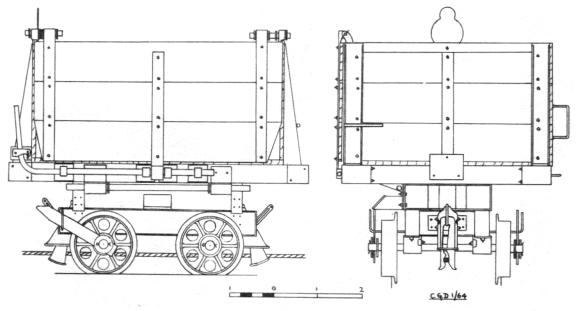
| THE INDUSTRIAL RAILWAY RECORD |
© SEPTEMBER 1965 |
NARROW GAUGE WAGONS
(4) WARNHAM BRICKWORKS
C. G. DOWN
At the Warnham Brickworks of the Sussex & Dorking United Brick Companies Ltd., in Sussex, is a 2'6" gauge railway operating in the claypit. About 300 yards in length, the line is worked by an 1800 ft. cable and is double track except near the working face, where the lines join and the wagons are hauled by a ‘Simplex‘ diesel locomotive to the loading point.
The cableway is worked in an anti-clockwise direction, and two types of wagon operate on it, The drawing shows no. 10, one of the wagon types now in the majority, which were built in the engineering workshops of the Company at intervals from about 1956 onwards. Others of this type are nos. 1-5, 7-14, and 19. They are basically similar, although the body size varies; in the case of no, 10, the body is constructed of 11" x 1" boards, At the four corners are tapering metal supports that hold the sides upright, while there is a door on one side, hinged at each end and secured by a long bar at the bottom. On the opposite side are handles; an overhead tipping device at the terminal engages these and tips the load.

The frames are constructed of H-section metal girders 7" deep, with metal plates welded over the ends. At one end only is a hook by means of which the wagon can be towed once it is off the cableway. The wheels are 15" diameter, 3¾" thick and the wheelbase is 28½". The wheels are free to slide on their axles to accommodate irregularities in the track and ease their passage on curves. On the axles are pivoted two metal bars; when the loaded wagon is attached t0 the cable, these bars are unhooked and allowed to trail behind, thus providing a safety device should the wagon become detached from the cable on the incline. The wagons are held on to the cable by a pair of ‘jaws‘ at each end of the wagon. These are normally in the ‘shut‘ position and are forced open by a ramp placed between the rails. While the jaws are held open the cable, which has come under the rails and into the centre of the ramp from the other track, slips in. The ramp ends abruptly, and the jaws snap shut on the cable, Removing the wagon from the cable is carried out in a similar manner. Finally, there is a piece of sheet metal projecting up from one end of the body. This engages with an electrically operated overhead "pusher" at the tip where the cable ends and saves the labour of manually pushing the wagons.
The original type of wagon was probably produced in the 1930's, nos. 15-18 still being in use. They are much smaller as they were tipped by hand before the tipping arrangements were altered in about 1956, the bodies being pivoted at a different point, These wagons are being replaced by the newer type at the time of writing (October 1964), but this may be delayed due to increased output. The cableway is due to be abandoned in September 1965 and it is hoped that either wagon 16 or 17 will go to Brockham Museum.
TAILPIECE
When the Lincolnshire Iron & Steel Institute held its annual dinner in 1965 the chief guest and principal speaker was Dr Richard Beeching, Chairman of the British Railways Board. As might be expected railways and transport costs featured largely in the speeches and general discussion. One of the more interesting responses came from Mr H.P. Forder, deputy managing director of The United Steel Companies Ltd., who observed that as he was standing behind a large table lamp he might be expected to give an illuminated address! However, he would content himself with pointing out proudly that Dr Beeching was not the only person in the room who sat on a railway board. He also had that position on the Stocksbridge Railway Company which had its very own Act of parliament, sealed by Queen Victoria. This railway was in top condition for every part of its length of 1 mile 41 chains, and had one diesel locomotive. It did not carry passengers, but under the requirements of the Act it must carry them if asked. A profit was made every year, and it was all very satisfactory with the only customers being the sole owners - a damn good way to run a railway! Mr Forder ended on a stern warning note. Dr Beeching, he said, had better not close the line that joined theirs. If he did, Queen Victoria would not be amused. (K.P.P.)